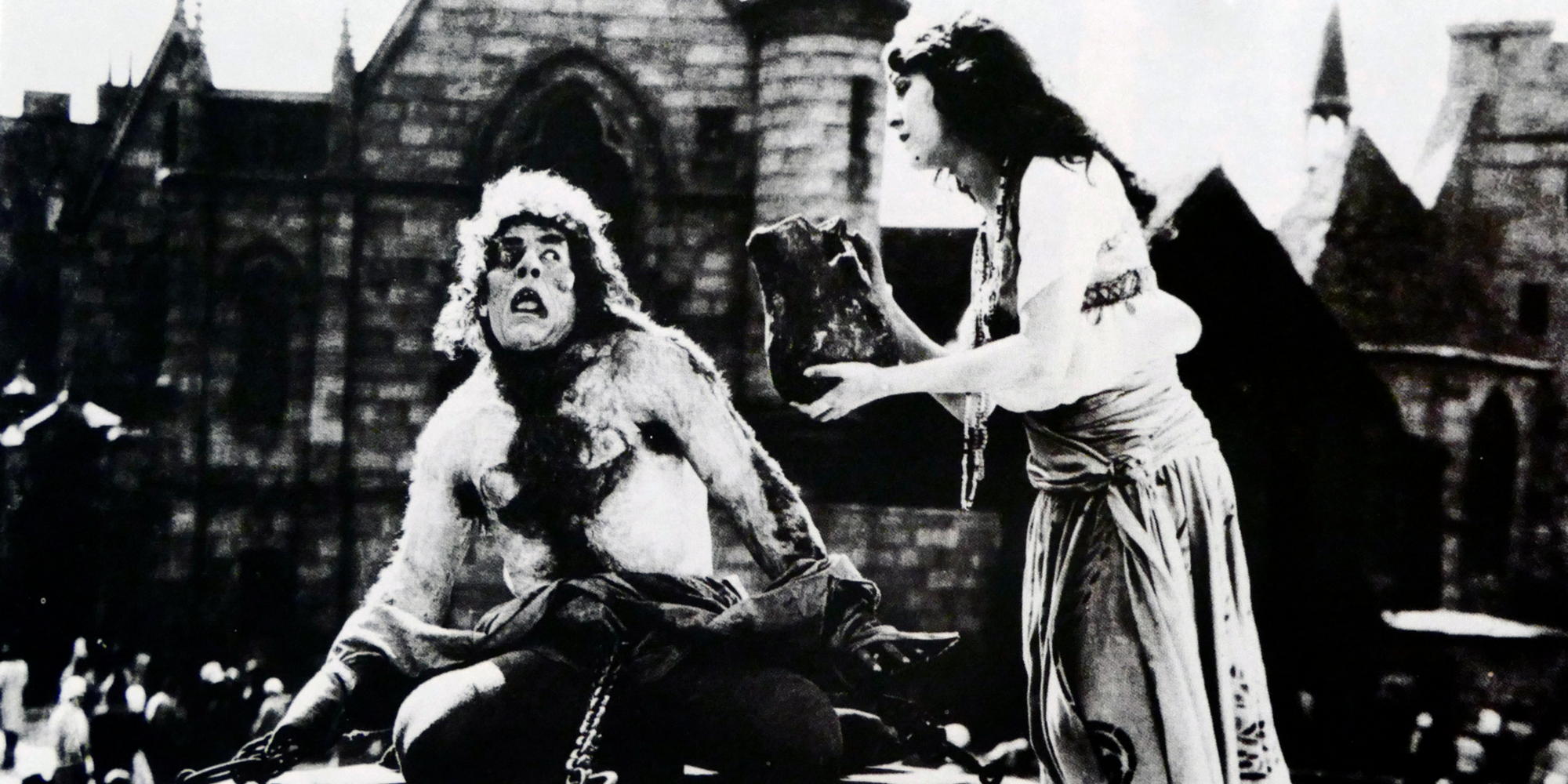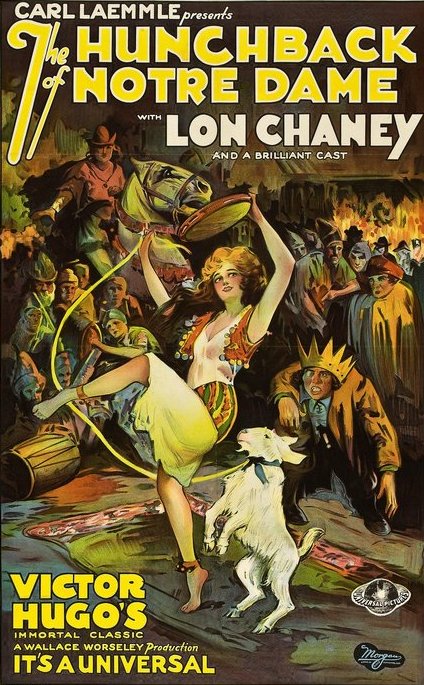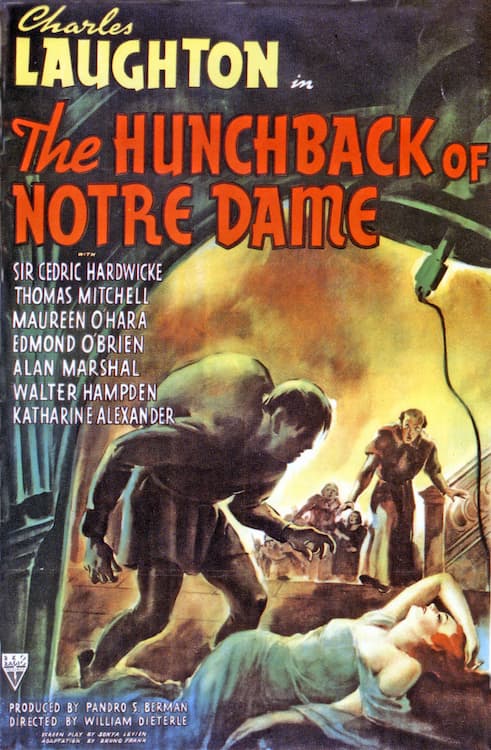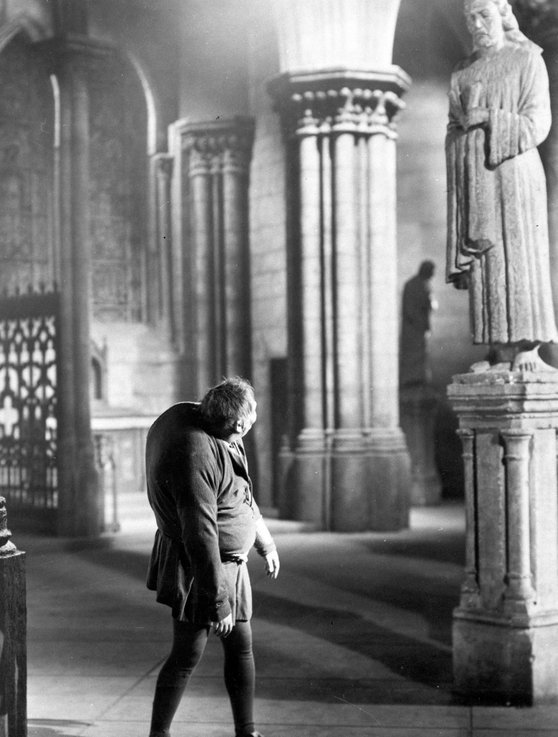
Book of the Week: The Hunchback of Notre-Dame
The Hunchback of Notre-Dame is the classic beauty and the beast tale written by Victor Hugo, the author of that other enduring tale of passion and tragedy, Les Miserables. Hugo, (1802 -1885) was a prolific novelist poet, playwright and politician. He became one of the masters of French romanticism, a literary movement that placed emphasis on emotion and individualism.

Poster of the 1923 silent film
Notre-Dame de Paris, as it was originally titled, was written in 1831 and set in medieval Paris. The great cathedral that dominates the city, standing majestically by the Seine, is in essence the central figure in the novel. Hugo takes great pains to provide the reader with an accurate picture of the church, describing its aisles, galleries, towers, intricate carvings and gargoyles. Hugo also conjures up the period in rich detail, which he absorbed from the poems of Francois Villon, the French poet of the late Middle Ages who was involved in criminal activities and had many brushes with the law which he wrote about in his poems. Hugo was able to scoop up such elements to create the background to his tale which involves thieves’ dens, masques, guilds and witch trials. Against this potent historical background, we are given a searing melodrama featuring Quasimodo, the deaf, deformed, grotesque bell ringer of the cathedral who is hopelessly in love with the beautiful, innocent Esmerelda, a singer and dancer. She is of Romany stock, a race that is shunned and persecuted by the authorities. Both these characters have a touching innocence in their natures which allows them to become the victims of capricious and merciless fate.
Quasimodo first meets Esmerelda at the Feast of Fools, an annual festival parodying ecclesiastical ritual and the cardinal elections. During the festival Quasimodo is elected ‘Pope of the Fools’ by the crowd and is subsequently beaten by the angry mob. He is generally regarded as an ugly unnatural beast and is often the target for the crowd’s violent disdain. Esmeralda takes pity on him and offers him a drink of water. Unused to kindness of any kind, Quasimodo’s heart softens and he falls in love with the dancer and vows to devote his life to protecting her.
In a story, imbued with such bleak and dramatic themes, there has to be a dyed in the wool villain. Here we have the devious and wicked Archdeacon Dom Claude Frollo who is Quasimodo’s guardian. He has ambitions to carry out genocide against the city’s Romany population. He also has lustful designs on Esmerelda. However, before he is able to make a move in this matter, she has fallen under the spell of the handsome womanising Captain Phoebus and is hopelessly in love with the young soldier.
Incensed with jealousy, Frollo stabs Phoebus but it is Esmerelda who arrested for his attempted murder. She is captured by the king’s guard and is subsequently sentenced to death. Qusimodo attempts to shelter Esmerelda in Notre-Dame. And so the plot spirals into further darkness with terrible consequences for Quasimodo and Esmerelda.

Poster for the 1939 film version
The novel was an immediate success and became extremely popular. It was translated into English within two years of its original publication and became a favourite novel of several notable writers, including Charles Dickens, Gustave Flaubert and Honore de Balzac. The novel also made the cathedral a national icon and served as a catalyst for the renewed interest in restoring many of France’s gothic structures. More significantly, it led to a series of major renovations at Notre-Dame in the 19th century and much of the cathedral’s present appearance is a result of these restorations.
The novel has been adapted in many dramatised forms, including ballets, operas, a rock musical, and several movie, television and radio versions. Book of the Week: The Hunchback of Notre-Dame
Perhaps it is the films which have done much to enhance the novel’s fame and reputation. In the early years of the twentieth century, the book was filmed three times in 1906, 1911 and 1917, but it was the 1923 version featuring Lon Chaney as Quasimodo that is the most memorable, not least because of Chaney’s performance. He was a master of makeup and with artifice he transformed himself into a hugely ungainly version of the misshapen bell ringer. He attached a seventy-pound rubber lump to his back, wore a leather harness that made it impossible for him to stand up straight, and donned a rubber suit covered with animal hair. Then, to disguise his facial features, he stuffed mortician’s wax into his mouth, puttied his cheeks, matted his hair and gave himself an ugly bulging false eye.
A gigantic replica of the Notre-Dame cathedral, precise in detail, was constructed on the Universal Studio’s lot and two thousand extras were used in the crowd scenes. There were several plot changes in this version. In order to ensure a happy ending, Esmerelda (Ruth Miller) is reunited with Captain Phoebus (Norman Kerry) after Quasimodo’s death.
The first sound feature was made by RKO in 1939 adapted by Bruno Frank which painted the world of King Louis XI in broad strokes, emphasising the contrast between rich and poor, freedom and repression, and medievalism and enlightenment that marked that particular era. Charles Laughton excelled as the doomed outcast. Maureen O’Hara was the beautiful Esmerelda and Cedric Hardwicke was a chilling Frollo. Again, a replica of the cathedral was constructed on the film lot, allowing Laughton to swing and gambol about its many turrets and gargoyles. Book of the Week: The Hunchback of Notre-DameBook of the Week: The Hunchback of Notre-Dame

Charles Laughton in the 1939 film
A French-Italian Cinemascope version came to the screen in 1956 with Anthony Quinn in the title role and Gina Lollobrigida as Esmerelda. They are the only two actors in the film to actually speak English. The rest of the cast comprised of French actors who had their voices dubbed. Quinn’s portrayal of the hunchback is less disfigured than most. However, notably this film is one of the few adaptations to use Victor Hugo’s original ending. But it lacks the power and passion of the Chaney and Laughton versions.
The Disney studio came up with a musical animated version of the story in 1996. Tom Hulce voiced Quasimodo and Demi Moore was Esmerelda, although her singing voice was provided by Heidi Mollenhauer. The excellent music was by Alan Menken who gave the whole project a kind of Broadway show flair. The film presents a simplified version of the original story, but of course, being a Disney production, there is also the addition of humour and romance. The success of this feature underlines the continuing appeal and fascination that Victor Hugo’s dark tale has on the public consciousness. Various adaptations can be entertaining in their own way, but it is the author’s original novel that holds the full power to entrance and bewitch with the magic of seductive storytelling.
David Stuart Davies
Our edition can be found here: Hunchback of Notre-Dame – Wordsworth Editions
Victor Hugo lived on Guernsey for fifteen years. The website of the Victor Hugo in Guernsey Society is here: The Victor Hugo in Guernsey Society
Main image: The 1923 silent film starring Lon Chaney and Mary Loretta Philbin, directed by Wallace Worsley, and produced by Carl Laemmle and Irving Thalberg. Credit: World History Archive / Alamy Stock Photo
Image 1 above: Poster for the 1923 film. Credit: World History Archive / Alamy Stock Photo
Image 2 above: Poster for the 1939 film. Credit: Pictorial Press Ltd / Alamy Stock Photo
Image 3 above: Charles Laughton in the 1939 film. Credit: PA Images / Alamy Stock Photo
Books associated with this article
